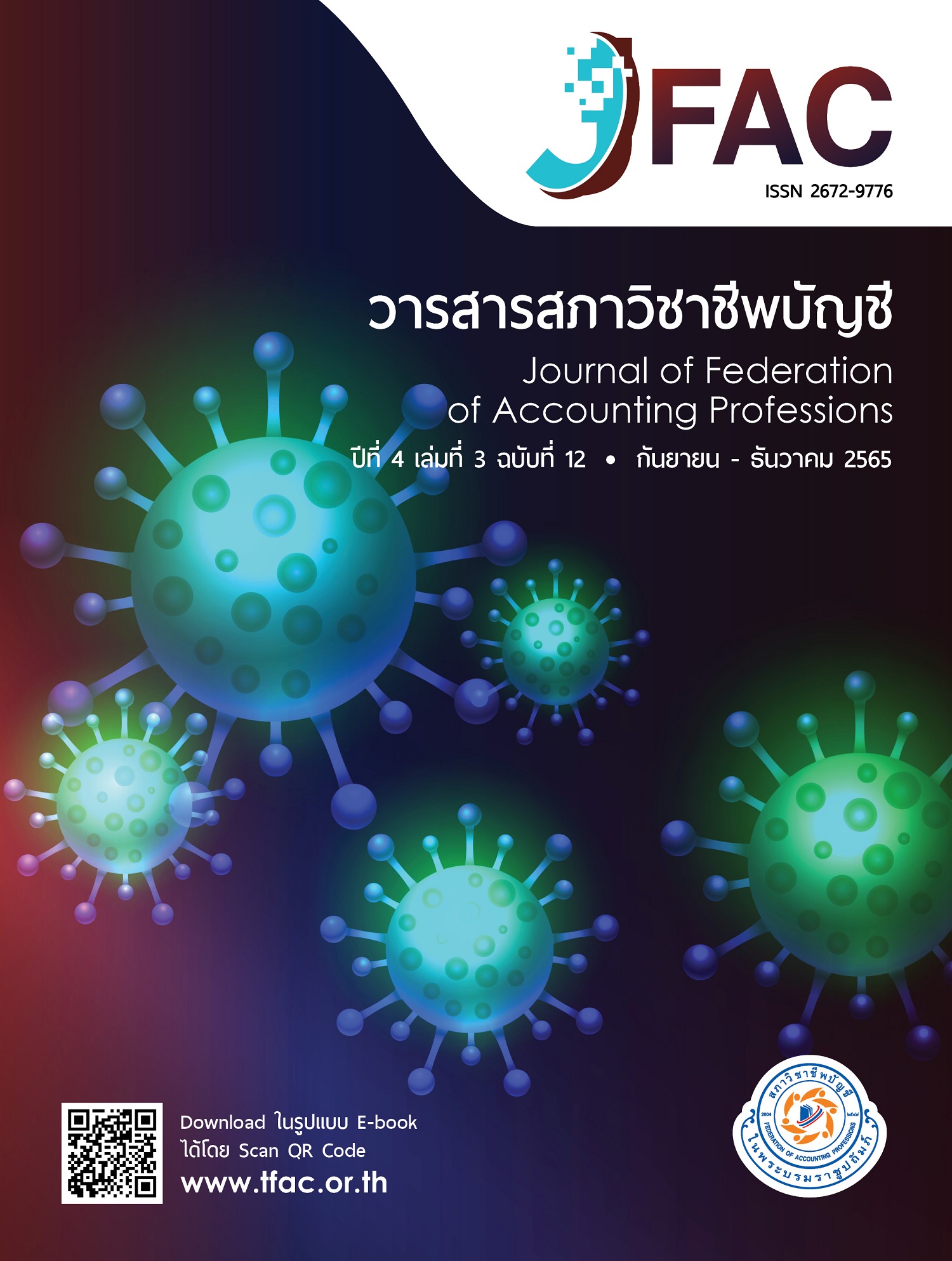แนวทางการตรวจสอบทดแทนการไม่สามารถตรวจนับสินค้าคงเหลือช่วงโควิด-19
Main Article Content
บทคัดย่อ
การศึกษานี้มีวัตถุประสงค์เพื่อสำรวจความคิดเห็นของผู้สอบบัญชีและผู้ช่วยผู้สอบบัญชีในการตรวจสอบสินค้าคงเหลือกรณีไม่สามารถเข้าสังเกตการณ์ได้ในช่วงโควิด-19 โดยเก็บข้อมูลจากผู้ตอบแบบสอบถามจำนวน 114 คน และวิเคราะห์ด้วยสถิติเชิงพรรณนา (ค่าเฉลี่ย ค่าสูงสุด ค่าต่ำสุด) และเชิงอนุมาน (Mann-Whitney U test และ Kruskal–Wallis test)
ผลการศึกษาพบว่าผู้ตอบแบบสอบถามให้ความเชื่อมั่นกรณีที่ไม่ได้เข้าสังเกตการณ์ตรวจนับสินค้า มากที่สุด คือ การทดสอบการควบคุม การตรวจสอบเนื้อหาสาระ และการวิเคราะห์เปรียบเทียบ ตามลำดับ โดยวิธีการทดสอบการควบคุมที่ให้ความสำคัญมากที่สุด ได้แก่ การตรวจหาการแก้ไขรายการที่มีความเสี่ยงสูง และ ให้ความสำคัญต่อการพิจารณาผลงานผู้ตรวจสอบภายในน้อยที่สุด ในขณะที่วิธีการตรวจสอบเนื้อหาสาระที่สำคัญมากที่สุด คือ การใช้ Data analytics ทดสอบยอดคงเหลือของสินค้าคงเหลือ การค้นหาสิ่งผิดปกติระหว่างปี และการนับสินค้าเป็นรอบ ตามลำดับ ส่วนการวิเคราะห์เปรียบเทียบได้ให้ความสำคัญมากที่สุด คือ การทดสอบความสัมพันธ์ของสินค้าคงเหลือกับรายการที่เกี่ยวข้อง โดยเรื่องที่เห็นด้วยน้อยที่สุด ได้แก่ การเปรียบเทียบยอดคงเหลือของงวดปัจจุบันกับงวดก่อน การศึกษาครั้งนี้ยังพบว่าปัจจัยด้านประชากรศาสตร์ที่มีผลต่อแนวทางการตรวจสอบ เช่น ประเภทของบริษัทตรวจสอบบัญชี ขนาดของกิจการที่ตรวจสอบ เป็นต้น การศึกษาครั้งนี้จะเป็นประโยชน์ในการวางแผนการตรวจสอบสินค้าคงเหลือในกรณีที่ไม่สามารถเข้าตรวจนับได้
Article Details
เนื้อหาและข้อมูลในบทความที่ลงตีพิมพ์ในวารสารสภาวิชาชีพบัญชี ถือเป็นข้อคิดเห็นและความรับผิดชอบของผู้เขียนบทความโดยตรงซึ่งกองบรรณาธิการวารสารไม่จำเป็นต้องเห็นด้วยหรือร่วมรับผิดชอบใด ๆ
บทความ ข้อมูล เนื้อหา รูปภาพ ฯลฯ ที่ได้รับการตีพิมพ์ในวารสารสภาวิชาชีพบัญชี ถือเป็นลิขสิทธิ์ของวารสารสภาวิชาชีพบัญชี หากบุคคลหรือหน่วยงานใดต้องการนำข้อมูลทั้งหมดหรือบางส่วนไปเผยแพร่ต่อหรือเพื่อกระทำการใดๆ จะต้องได้รับอนุญาตเป็นลายลักษณ์อักษรจากวารสารสภาวิชาชีพบัญชี ก่อนเท่านั้น
เอกสารอ้างอิง
References
Appelbaum, Deniz. (2020). Auditing and Accounting During and After the COVID-19 Crisis. Retrieved from https://www.cpajournal.com/2020/07/08/auditing-and-accounting-during-and-after-the-covid-19-crisis/
Audsabumrungrat, J. (2020). Is it time for us to adopt Remoting Audit ?. Retrieved from https://www.tfac.or.th /upload/9414/u1H3XbDOW3.pdf
Carl R. Mayes Jr. (2020). How to audit during a pandemic? You asked. We answered. Retrieved from https://www.aicpa.org/news/article/how-to-audit-during-a-pandemic-you-asked-we-answered
Deloitte. (2020). Observing inventory in a different way. Retrieved from https://www2.deloitte.com/content/dam/Deloitte/us/Documents/risk/us-observing-inventory-in-a-different-way-new.pdf
Dohrer, Bob. (2020). How auditors can test inventory without a site visit. Retrieved from https://www.journal ofaccountancy.com/news/2020/mar/auditing-how-to-observe-inventory-during-coronavirus-pandemic.html
Fisher, L. (2015). Big data transforming how audits are carried out. AB Magazine. Retrieved from http://www.accaglobal.com/pk/en/member/member/accounting-business/insights/big-data.html.
Ginman, Paul. (2020). Webinar 2: Performing the Audit in the Pandemic Environment. International Federation of Accountants (IFAC).
International Auditing and Assurance Standards Board (IAASB) (2016). Exploring the Growing Use of Technology on the Audit, with a Focus on Data Analytics. Retrieved from https://www.iaasb.org/publications/exploring-growing-use-technology-audit-focus-data-analytics.
Kanasoot, P. (1999). Statistic for Behavioral Science Research. (3rd Ed.). Bangkok: Chulalongkorn University Press.
KPMG. (2020a). Transforming inventory counting. Retrieved from https://info.kpmg.us/content/dam/info/en/news-perspectives/pdf/2021/4498%20-%20Transforming%20inventory%20counting%20TL_secured_vF.pdf
KPMG. (2020b). Physical inventory count amid COVID-19. Retrieved from https://assets.kpmg/content/dam /kpmg/in/pdf/2020/03/chapter-2-aau-covid-19-financial-reporting-inventory-impact-relaxations.pdf
KPMG. (2020c). How analyzing data signals can help businesses. Retrieved from https://home.kpmg/xx/en/blogs /home/posts/2020/05/how-analyzing-data-signals-help-businesses.html
Mahbod, Reza. (2020). Overcoming site visit limitations in the pandemic. Retrieved from https://www.journal ofaccountancy.com/news/2020/may/overcoming-auditing-site-visit-limitations-during-coronavirus-pandemic.html
Ministry of Corporate Affairs (MCA) (2016). Company Auditor’s Report Order (CARO), 2016 – Reporting Requirements. Retrieved from https://www.aicpa.org/news/article/how-to-audit-during-a-pandemic-you-asked-we-answered.
Permsirivallop, S. (2016). Technology Innovation Wave and Audit Profession. Journal of Accounting Professions, 12(34), 59-62.
Thailand Federation of Accounting Professions. (2020). Audit operations in epidemic situations. Retrieved from https://www.tfac.or.th/upload/9414/3xkINpPMjk.pdf
Thailand Federation of Accounting Professions. (2021). Thai Accounting Standard (TAS) 2 Inventory. Retrieved from https://www.tfac.or.th
Thailand Federation of Accounting Professions. (2020). International Standard on Auditing (ISA) 500 Audit Evidence. Retrieved from https://www.tfac.or.th
Thailand Federation of Accounting Professions. (2020). International Standard on Auditing (ISA) 501 Audit Evidence--Additional Considerations for Specific Items. Retrieved from https://www.tfac.or.th
Thailand Federation of Accounting Professions. (2020). International Standard on Auditing (ISA) 600 (Revised) Special Considerations--Audits of Group Financial Statements (Including the Work of Component Auditors). Retrieved from https://www.tfac.or.th
Thailand Federation of Accounting Professions. (2020). International Standard on Auditing (ISA) 610 (Revised 2013) Using the Work of Internal Auditors and Related Conforming Amendments. Retrieved from https://www.tfac.or.th
Thailand Federation of Accounting Professions. (2020). International Standard on Auditing (ISA) 620 Using the Work of an Expert. Retrieved from https://www.tfac.or.th
Thailand Federation of Accounting Professions. (2020). International Standard on Auditing (ISA) 705 (Revised) Moditfications to the Openion in the Independent Auditor’s Report. Retrieved from https://www.tfac.or.th


